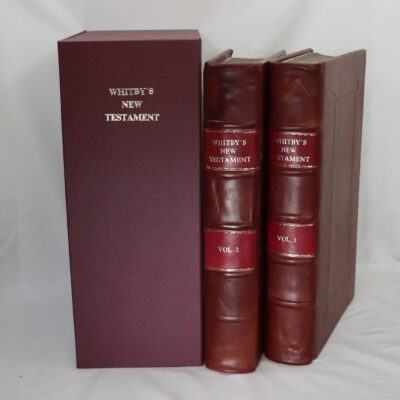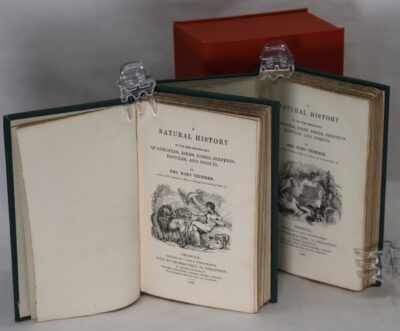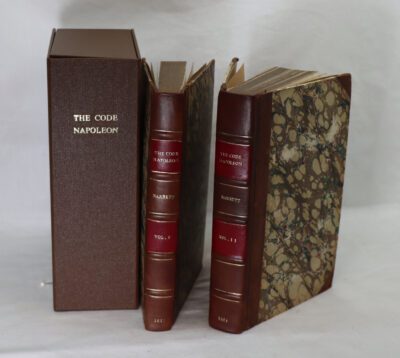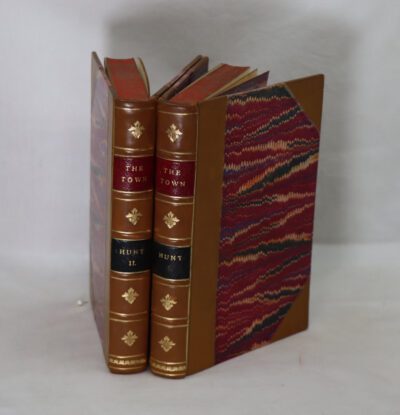James's Dispensory.
By R.James
Printed: 1764
Publisher: T Osborne. W Stahan. London
Edition: third edition
| Dimensions | 14 × 21 × 5 cm |
|---|---|
| Language |
Language: English
Size (cminches): 14 x 21 x 5
Condition: Very good (See explanation of ratings)
FREE shipping
Your items
Item information
Description
Tan leather binding with raised banding, red title plate and gilt title on the spine.
A book which marks the cultural divide from the old medieval world to the scientific.
An important book on the standardisation of medicine and a significant transit from the world of medieval potions, lotions, and prayer.
A pharmacopoeia, pharmacopeia, or pharmacopoea (from the obsolete typography pharmacopœia, literally, “drug-making”), in its modern technical sense, is a book containing directions for the identification of compound medicines, and published by the authority of a government or a medical or pharmaceutical society.
Descriptions of preparations are called monographs. In a broader sense it is a reference work for pharmaceutical drug specifications.
Until 1617, such drugs and medicines as were in common use were sold in England by the apothecaries and grocers. In that year the apothecaries obtained a separate charter, and it was enacted that no grocer should keep an apothecary’s shop. The preparation of physicians’ prescriptions was thus confined to the apothecaries, upon whom pressure was brought to bear to make them dispense accurately, by the issue of a pharmacopoeia in May 1618 by the College of Physicians, and by the power which the wardens of the apothecaries received in common with the censors of the College of Physicians of examining the shops of apothecaries within 7 m. of London and destroying all the compounds which they found unfaithfully prepared. This, the first authorized London Pharmacopoeia, was selected chiefly from the works of Mezue and Nicolaus de Salerno, but it was found to be so full of errors that the whole edition was cancelled, and a fresh edition was published in the following December.
At this period the compounds employed in medicine were often heterogeneous mixtures, some of which contained from 20 to 70, or more, ingredients, while a large number of simples were used in consequence of the same substance being supposed to possess different qualities according to the source from which it was derived. Thus crabs’ eyes (i.e., gastroliths), pearls, oyster shells, and coral were supposed to have different properties. Among other ingredients entering into some of these formulae were the excrements of human beings, dogs, mice, geese, and other animals, calculi, human skull, and moss growing on it, blind puppies, earthworms, etc.
Although other editions of the London Pharmacopoeia were issued in 1621, 1632, 1639, and 1677, it was not until the edition of 1721, published under the auspices of Sir Hans Sloane, that any important alterations were made. In this issue many of the remedies previously in use were omitted, although a good number were still retained, such as dogs’ excrement, earthworms, and moss from the human skull; the botanical names of herbal remedies were for the first time added to the official ones; the simple distilled waters were ordered of a uniform strength; sweetened spirits, cordials and ratafias were omitted as well as several compounds no longer used in London, although still in vogue elsewhere. A great improvement was effected in the edition published in 1746, in which only those preparations were retained which had received the approval of the majority of the pharmacopoeia committee; to these was added a list of those drugs only which were supposed to be the most efficacious. An attempt was made to simplify further the older formulae by the rejection of superfluous ingredients.
In the edition published in 1788 the tendency to simplify was carried out to a much greater extent, and the extremely compound medicines which had formed the principal remedies of physicians for 2,000 years were discarded, while a few powerful drugs which had been considered too dangerous to be included in the Pharmacopoeia of 1765 were restored to their previous position. In 1809 the French chemical nomenclature was adopted, and in 1815 a corrected impression of the same was issued. Subsequent editions were published in 1824, 1836, and 1851.
Sir Hans Sloane, 1st Baronet PRS (16 April 1660 – 11 January 1753), was an Anglo-Irish physician, naturalist, and collector, with a collection of 71,000 items which he bequeathed to the British nation, thus providing the foundation of the British Museum, the British Library, and the Natural History Museum, London. He was elected to the Royal Society at the age of 24. Sloane travelled to the Caribbean in 1687 and documented his travels and findings with extensive publications years later. Sloane was a renowned medical doctor among the aristocracy and was elected to the Royal College of Physicians at age 27. He is credited with creating drinking chocolate. Streets and places were later named after him, including Hans Place, Hans Crescent, and Sloane Square in and around Chelsea, London – the area of his final residence – and also Sir Hans Sloane Square in his birthplace in Ireland, Killyleagh.
After studying medicine and botany in London, Paris and Montpellier, Sloane graduated from the University of Orange in 1684 as an MD and moved to London to practice; he was hired as an assistant to prominent physician Thomas Sydenham who gave the young man valuable introductions to practice.
In his own practice, started in 1689 at 3 Bloomsbury Place, London, Sloane worked among the upper classes where he was viewed as fashionable; he built a large practice which became lucrative. The physician served three successive sovereigns: Queen Anne, George I, and George II.
There was some criticism of Sloane during his lifetime as a mere “virtuoso”, an undiscriminating collector who lacked understanding of scientific principles. One critic stated that he was merely interested in the collection of knick-knacks, and another called him the “foremost toyman of his time”. Sir Isaac Newton described Sloane as “a villain and rascal” and “a very tricking fellow”. Some believed that his true achievement was in making friends in high society and with important political figures, rather than in science. Even as a physician, he did not get a great deal of respect from many, being seen as primarily a seller of medications and a collector of curios. Sloane’s only medical publication, an Account of a Medicine for Soreness, Weakness and other Distempers of the Eyes (London, 1745), was not published until its author was in his eighty-fifth year and had retired from practice.
In 1716 Sloane was created a baronet, making him the first medical practitioner to receive a hereditary title. In 1719 he became president of the Royal College of Physicians, holding the office for sixteen years. In 1722 he was appointed physician-general to the army, and in 1727 first physician to George II.
He was elected president of Royal College of Physicians in 1719 and served in that role until 1735. He became secretary to the Royal Society in 1693, and edited its Philosophical Transactions for twenty years. In 1727 he succeeded Sir Isaac Newton as president. He retired from the Society at the age of eighty.
Sloane’s role as First Secretary and later President of the Royal Society, a period which included his revitalising editorship of the Philosophical Transactions, permitted Sloane little time for progressing his own scientific research, which led to the criticism of Sloane as a mere “virtuoso”.
Aside from his service as Royal Physician, Sloane’s true achievement during his time at the Royal Society was in acting as a conduit between the worlds of science, politics and high society.
Sloane’s time in France at the beginning of his career later enabled him to fulfil the role of intermediary between British and French scientists, fostering the sharing of knowledge between the two countries at the height of the Age of Enlightenment. Notables from that period who visited Sloane to view his collection include the Swiss anatomist Albrecht von Haller, Voltaire, Benjamin Franklin and Carl Linnaeus.
In 1745, at the age of eighty-five and after having retired from medical practice, Sloane published his first medical work, Account of a Medicine for Soreness, Weakness and other Distempers of the Eyes (London, 1745).
Want to know more about this item?

Related products
Share this Page with a friend














